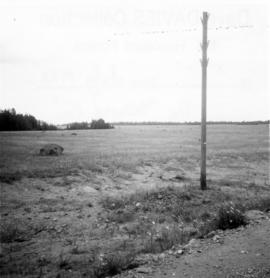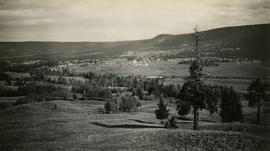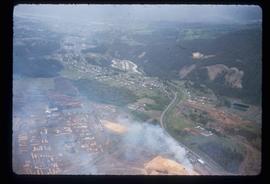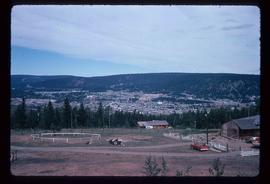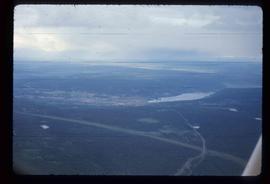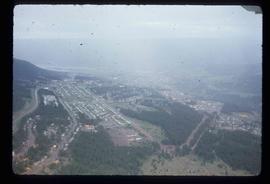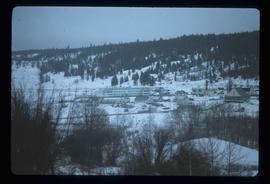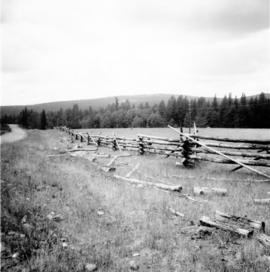Photograph depicts a telegraph line on the Williams Lake to Bella Coola road.
Williams Lake, BC
66 Archival description results for Williams Lake, BC
Photograph depicts a view of the community of Williams Lake, taken from the Chilcotin Road to the west.
Collection consists of digitized home videos created by the Viksten family. The videos include scenes of Horsefly Lake and the Williams Lake Stampede.
This West Fraser Timber Company Ltd. 50th anniversary video covers the history of the company through interviews, narration, and historical images.
Collection consists of a 50th anniversary video about the history of the West Fraser Timber Company Ltd.
Files contain a grade six report card, high school entrance certificate, certificates of appointment to various positions, a photocopy about the Dow Family, a map of the Cariboo District, Judge Ferry’s law degree from the University of British Columbia, his Law Society diplomas and his certificate of appointment to the Supreme Court of British Columbia.
Series consists of records and photographs relating to Judge William Ferry's life and career. Includes school records from Prince George Public School and the University of British Columbia, military photographs, and records, certificates and photographs relating to his his judicial career.
Ferry, William DowPortrait photograph shows William D. Ferry in his judicial robes.
Image depicts an aerial view of Williams Lake, B.C.
Image depicts a view of Williams Lake, B.C.
Image depicts an aerial view of Williams Lake, B.C.
Image depicts an aerial view of Williams Lake, B.C.
Image depicts an aerial view of Williams Lake, B.C.
File contains slides depicting places in the area around Williams Lake, Clinton, and the Fraser Canyon.
Image depicts the St. Joseph's Residential School in Williams Lake, B.C.
According to the National Centre for Truth and Reconciliation Archives (https://archives.nctr.ca/Cariboo-Residential-School) :
"Cariboo (Williams Lake) Indian Residential School (IRS) was located southwest of Williams Lake on highway #97 approximately halfway between Quesnel and Kamloops in the BC interior. The IRS operated from 1891 - 1981 (90 years) and closed on June 30, 1981.
Other names identifying the residential school include Williams Lake Industrial School and St. Joseph’s Industrial School from 1891 - 1920; Cariboo Industrial School and Cariboo Indian Industrial School from 1920 - 1927; Cariboo Residential School and Cariboo Indian Residential School from 1923 - 1981; St. Joseph’s Mission School (1929 - 1981), St. Joseph’s Indian Residential School (1932 and 1935), and St. Joseph’s Residential School (1963 and 1969); Cariboo Student Residence and Cariboo Indian Student Residence from 1967 - 1981. The school was also frequently referred to as the Indian School at 150 Mile House because of its location.
The Government of Canada was responsible for funding the school, which was managed and operated by the Roman Catholic Church from July 1891 - March 31, 1969. From April 1, 1969 - June 1981, the federal government managed and operated the IRS. In 1962, an agreement was signed between Her Majesty the Queen in Right of Canada represented by the Minister of Citizenship and Immigration and Indianescom (Oblate Indian and Eskimo Commission) for the management and operation of the Cariboo IRS.
No information regarding which grades were taught at the IRS exists.
Students were from the following bands: Alexandria, Alexis Creek, Alkali Lake, Anaham, Anderson Lake, Ashcroft, Bonaparte, Bridge River, Canim Lake, Canoe Creek, Clinton, Coldwater, Cowichan, Dog Creek, Euchinico, Fountain, High Bar, Kamloops, Kluskus Lake (Kluxkux Lake), Kuklinko, Lake Babine, Lillooet, Little Shuswap, Moricetown, Mount Currie, Natzoo, Nazko, Nemiah Valley, North Thompson, Pavillion, Pemberton, Quesnel, Redstone, Riske Creek, Seton Lake, Skwah, Soda Creek, Squamish, Stone (Stoney), Taodistan, Toosey, Ulkatcho (Ulgatcho), and Williams Lake. "was opened was opened by Roman Catholic missionaries in 1891. In 1902 nine boys ran away from the school, one of them dying of exposure. In 1920, nine boys ate poisonous water hemlock in what parents believed to be a response to discipline at the school. One of these boys died. The school closed in 1981. In the 1980s and 1990s two former staff members pled guilty to charges of sexually abusing students in the 1950s and 1960s. In 1998, a former principal apologized to a former student and school employee who had charged him with a series of sex offences. "
Photograph taken on the Williams Lake to Bella Coola road.
